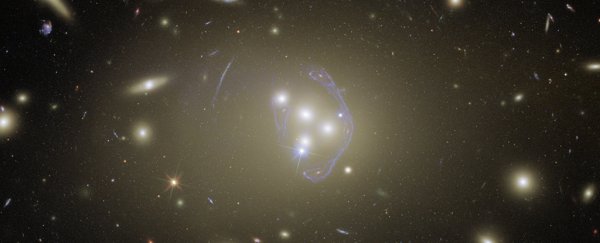We're now used to seeing beautiful shots of space taken by the Hubble Space Telescope, but that doesn't mean they're not still jaw-dropping in their gorgeousness – and this picture of galaxy cluster Abell 3827 certainly fits that description.
What you're looking at here is a cluster of hundreds of galaxies of different shapes and sizes, some 1.4 billion light-years away from Earth, with the elliptical ESO 146-5 galaxy at the center – thought to be one of the most massive in the known Universe because of its strong gravitational lensing effect (shown by the uneven blue halo).
Light across four different wavelengths was captured and combined to produce this truly stunning image, and the more you look at it, the better it gets.
The Advanced Camera for Surveys (ACS) and Wide Field Camera 3 (WFC3) on board Hubble were both used in capturing what you see here.
 (ESA/Hubble & NASA, R. Massey)
(ESA/Hubble & NASA, R. Massey)
"Looking at this cluster of hundreds of galaxies, it is amazing to recall that until less than 100 years ago, many astronomers believed that the Milky Way was the only galaxy in the Universe," writes the European Space Agency (ESA) team that published the picture.
"The possibility of other galaxies had been debated previously, but the matter was not truly settled until Edwin Hubble confirmed that the Great Andromeda Nebula was in fact far too distant to be part of the Milky Way."
Abell 3827 is of particularly interest to astronomers because it's thought to contain pockets of dark matter – the elusive and invisible mass that could make up as much as 85 percent of the total amount of material in existence.
While studies of Abell 3827 and other galaxy clusters like it continue, we're happy to just sit back in awe at the scale and the quality of the image that the Hubble telescope has managed to produce here.
The telescope just celebrated 31 years of snapping the celestial skies, releasing an image of the giant, ultra-bright star AG Carinae as it battles against self destruction – a star some 70 times bigger and 1 million times brighter than our own Sun.
Last year, for Hubble's 30th birthday, we were treated to a whole cascade of new photos released to mark the occasion. Since heading into space in April 1990, the telescope has taken around 1.5 million snaps of roughly 48,000 stars, planets and galaxies.
Even with such a rich catalog to its name, we think this latest image might be one of our favorites of the whole Hubble Space Telescope collection – and as research into dark matter continues, expect to hear more about Abell 3827 along the way.
You can read more about the image on the ESA website.
